当前位置:网站首页>Visualization Road (10) detailed explanation of segmentation canvas function
Visualization Road (10) detailed explanation of segmentation canvas function
2022-04-23 10:53:00 【The big pig of the little pig family】
Detailed explanation of split canvas function
One . Preface
In the use of matplotlib In the process of data visualization , We are inseparable from an important carrier – canvas (Figure). One Figure Object is the top-level container for all drawing elements , Want to realize the rational use of canvas , Partition use is essential .
First of all, understand the concept of sub area , As the name suggests, the sub area is to put the big canvas (FIgure) Divided into several sub canvases , These sub canvases form the drawing area , Its essence is to add coordinate axis system to the crisscross row and column grid . Next, I will mainly introduce 3 A correlation function , All the example codes in the following are in Ipython Implemented on , And the related library import and Chinese modification statements have been omitted , The method mentioned in this paper is equivalent to function .
Two .subplots function
This function is the simplest and most direct , call plt.subplots() Will directly create a 1 That's ok 1 Grid layout subinterval of column , Create a Figure object .
2.1 Function definition
subplots(nrows=1,
ncols=1,
*,
sharex=False,
sharey=False,
squeeze=True,
subplot_kw=None,
gridspec_kw=None,
fig_kw)
Parameter description :
Parameters 1:nrows: Integer type , Specify the number of rows in the subgraph grid
Parameters 2:ncols: Integer type , Specify the number of columns in the subgraph grid
Parameters 3:sharex: Boolean or character , Specify whether to share x Axis , Optional {‘none’,‘all’,‘row’,‘col’}
none: Equate to False, Specifies that all subgraphs are not shared
all: Appoint x Axis or y The axis will be shared among all subgraphs
row: Specifies that each row of subgraphs will share a x Axis or y Axis
col: Specifies that each column of subgraphs will share a x Axis or y Axis
Parameters 4:sharey: Boolean or character , Specify whether to share y Axis , Optional {‘none’,‘all’,‘row’,‘col’}
none: Equate to False, Specifies that all subgraphs are not shared
all: Appoint x Axis or y The axis will be shared among all subgraphs
row: Specifies that each row of subgraphs will share a x Axis or y Axis
col: Specifies that each column of subgraphs will share a x Axis or y Axis
Parameters 5:squeeze: Boolean type , Specify whether to compress
Parameters 6:subplot_kw: Dictionary type , Pass to add_subplot Method , Specify the key parameters of the call to create each subgraph
Parameters 7:gridspec_kw: Dictionary type , Pass to GridSpec class , Specify the keyword parameters of the grid placed by the subgraph
Parameters 8:**fig_kw: Dictionary type , Pass to pyplot.figure Method
Return value 1:FIgure example
Return value 2:Axes Example or Axes Instance array , The array has the same shape as the grid
Parameters, :
- fig_kw Parameters passed to pyplot.figure Method means that all the contents of the parameter will be passed directly to plt.figure Method .subplot_kw、subplot_kw Empathy .
- For parameters squeeze, If True And construct only one subgraph , Returns a single Axes Object will be returned as a scalar . about Nx1 or 1xM Subgraphs , The returned object contains Axes Object's numpy Array . about N×M individual , Sub district and N> 1 and M> 1 Return to 2D array . If False, No compression at all : Back to Axes Objects always contain Axes Example of 2D Array , Even if it turns out to be 1x1. See below for specific examples .
2.2 Function explanation
The advantage of this function is that it can be done in one step , establish Figure Object while creating the grid layout of the specified rows and columns , A lot less code . The following is the internal implementation of this function :
fig = figure(fig_kw) # establish Figure object
axs = fig.subplots(nrows=nrows, # Designated line
ncols=ncols, # Specified column
sharex=sharex, # Specify whether to share X Axis
sharey=sharey, # Specify whether to share y Axis
squeeze=squeeze, # Specifies whether to compress the return value
subplot_kw=subplot_kw,
gridspec_kw=gridspec_kw)
return fig, axs # return Figure Object and coordinate system
You can see the call plt.figure Function and pass arguments fig_kw And create a Figure object , This is what I said above to pass on to plt.figure Function means . Then call Figure.subplots Method to create grid layout and coordinate axis system . Here is fig.subplots Core code :
if self.get_constrained_layout():
gs = GridSpec(nrows, ncols, figure=self, gridspec_kw) # establish GridSpec Class instance
else:
# this should turn constrained_layout off if we don't want it
gs = GridSpec(nrows, ncols, figure=None, gridspec_kw)
self._gridspecs.append(gs)
# Create array to hold all axes.
axarr = np.empty((nrows, ncols), dtype=object) # Create an empty matrix , Type is object
# Cycle to create a coordinate system , Subscript 0 Start
for row in range(nrows):
for col in range(ncols):
shared_with = {
"none": None, "all": axarr[0, 0],"row": axarr[row, 0], "col": axarr[0, col]} #sharex and sharey Check your dictionary
subplot_kw["sharex"] = shared_with[sharex] # Dictionary values
subplot_kw["sharey"] = shared_with[sharey] # Dictionary values
axarr[row, col] = self.add_subplot(gs[row, col], subplot_kw) # Create a coordinate system
# turn off redundant tick labeling
# Setup and share X Axis
if sharex in ["col", "all"]:
# turn off all but the bottom row
for ax in axarr[:-1, :].flat:
ax.xaxis.set_tick_params(which='both', labelbottom=False, labeltop=False)
ax.xaxis.offsetText.set_visible(False)
# Setup and share Y Axis
if sharey in ["row", "all"]:
# turn off all but the first column
for ax in axarr[:, 1:].flat:
ax.yaxis.set_tick_params(which='both', labelleft=False, labelright=False)
ax.yaxis.offsetText.set_visible(False)
if squeeze:
return axarr.item() if axarr.size == 1 else axarr.squeeze() # call squeeze Delete one-dimensional pressing method
else:
return axarr # Returns a two-dimensional matrix
First create GridSpec Class instance , This class is used to specify the geometry of the mesh . Then cycle through the creation of the coordinate system , And add it to an empty matrix , here squeeze Parameters and have an effect , The return value is a two-dimensional matrix of the specified shape , The next two if-for The code block is used to set sharex and sharey Parameter response . Finally, squeeze Parameter detection , Assuming that True Return a pure instance or a two-dimensional matrix according to the number of rows and columns , Assuming that False Returns a two-dimensional matrix anyway .
2.3 Example of function
2.3.1squeeze Parameter example
First create a 1 That's ok 1 Grid layout of columns ,squeeze Parameter is False, Look at its return value :
fig, ax = plt.subplots(squeeze=False)
ax.shape, ax
The result is as follows :
((1, 1), array([[<AxesSubplot:>]], dtype=object))
The proof returns a binary array , Not an object , The following will squeeze The parameter is changed to True:
fig, ax = plt.subplots(squeeze=True)
ax
The result is as follows :
<AxesSubplot:>
The return value is simply an object . But what if we set multiple rows or columns ?
fig, ax2 = plt.subplots(2, 2, squeeze=True)
ax2.shape, ax2
fig, ax1 = plt.subplots(2, 2, squeeze=False)
ax1.shape, ax1
The result is as follows :
((2, 2),
array([[<AxesSubplot:>, <AxesSubplot:>],
[<AxesSubplot:>, <AxesSubplot:>]], dtype=object))
((2, 2),
array([[<AxesSubplot:>, <AxesSubplot:>],
[<AxesSubplot:>, <AxesSubplot:>]], dtype=object))
Prove that in the case of multiple rows and columns ,squeeze It doesn't matter .
2.3.2 Comprehensive examples
fig, ax = plt.subplots(2, 3)
colors_list = ['#8dd3c7', '#ffffb3', '#bebada']
ax[0, 0].bar([1, 2, 3], [0.6, 0.2, 0.8], color=colors_list, width=0.8, hatch='///', align='center')
ax[0, 0].errorbar([1, 2, 3], [0.6, 0.2, 0.8], yerr=0.1, capsize=0, ecolor='#377eb8', fmt='o:')
ax[0, 1].errorbar([1, 2, 3], [20, 30, 36], xerr=2, ecolor='#4daf4a', elinewidth=2, fmt='s', label='ETN')
ax[0, 1].legend(loc=3, fancybox=True, shadow=True, fontsize=10, borderaxespad=0.4)
ax[0, 1].set_ylim(10, 40)
ax[0, 1].set_xlim(-2, 6)
x3 = np.arange(1, 10, 0.5)
y3 = np.cos(x3)
ax[0, 2].stem(x3, y3, basefmt='r-', linefmt='b-.', markerfmt='bo', label='life signal')
ax[0, 2].legend(loc=2, fancybox=True, shadow=True, frameon=False, fontsize=8, borderaxespad=0.6, borderpad=0.0)
ax[0, 2].set_ylim(-2, 2)
ax[0, 2].set_xlim(0, 11)
x4 = np.linspace(0, 2*np.pi, 500)
x4_1 = np.linspace(0, 2*np.pi, 1000)
y4 = np.cos(x4)*np.exp(-x4)
y4_1 = np.sin(2*x4_1)
line1, line2 = ax[1, 0].plot(x4, y4, 'k--', x4_1, y4_1, 'r-', lw=2)
ax[1, 0].legend((line1, line2), ('energy', 'patience'), loc=2, fancybox=True, shadow=True, framealpha=0.3,mode='expand', fontsize=8, ncol=2, columnspacing=2, borderpad=0.1, markerscale=0.1)
ax[1, 0].set_ylim(-2, 2)
ax[1, 0].set_xlim(0, 2*np.pi)
x5 = np.random.rand(100)
ax[1, 1].boxplot(x5, vert=False, showmeans=True, meanprops=dict(color='black'))
ax[1, 1].set_yticks([])
ax[1, 1].set_xlim(-1.1, 1.1)
ax[1, 1].set_ylabel('Miscro SD Card')
ax[1, 1].text(-1.0, 1.2, 'net weight', fontsize=15, style='italic', weight='black', family='monospace')
mu = 0.0
sigma = 1.0
x6 = np.random.randn(10000)
n, bins, patches = ax[1, 2].hist(x6, bins=30, histtype='stepfilled', cumulative=True, color='cornflowerblue',
label='Test', density=True)
y = ((1 / (np.sqrt(2 * np.pi) * sigma)) * np.exp(-0.5 * (1 / sigma * (bins-mu)) 2))
y = y.cumsum()
y /= y[-1]
ax[1, 2].plot(bins, y, 'r--', lw=1.5, label='Theory')
ax[1, 2].set_ylim([0.0, 1.1])
ax[1, 2].grid(ls=':', lw=1, color='grey', alpha=0.5)
ax[1, 2].legend(fontsize=8, shadow=True, fancybox=True, framealpha=0.8)
ax[1, 2].autoscale()
plt.show()
The result is as follows :
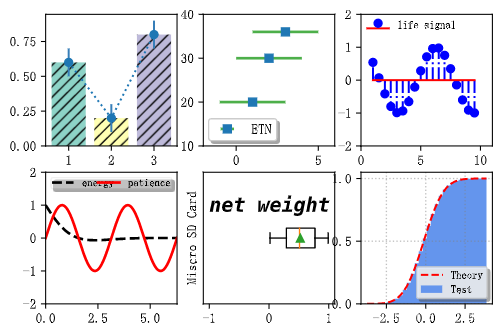
3、 ... and .plt.subplot function
This function is a pair of Figure.add_subplot Packaging of methods , Its purpose is to add the axis to the existing Figure object , Or retrieve an existing axis , Its core statement is fig = gcf() Get current Figure object .
3.1 Function definition
subplot There are many forms , Some examples are as follows :
subplot(nrows, ncols, index, kwargs)
subplot(pos, kwargs)
subplot(kwargs)
subplot(ax)
Parameter description :
Parameters 1:* args: Specify the method of describing the subgraph
(nrows,ncols,index): Specify the number of lines 、 The number of columns and the index of the currently active subgraph , Index from the top left corner 1 Start and increase to the right . The index can also be specified as a two element tuple (start, end) , That is, draw a cross region subgraph
Three digit integer : Hundred bit 、 ten 、 Each bit specifies the number of rows 、 Number of columns and index , Only if the number of subgraphs does not exceed 9 Use only after a period of time .
Parameters 2:projection: Specify the axis projection ,{None,“ aitoff”,“ hammer”,“ lambert”,“ mollweide”,“ polar”,“ rectalinear”,str}
Parameters 3:polar: Boolean type , Specify whether to use projection=‘polar’, That is, use the polar coordinate system
Parameters 4:sharex: Specify whether to share X Axis
Parameters 5:sharey: Specify whether to share Y Axis
Parameters 6:label: Specify the axis label
Return value : Returns the axis base class based on the specified projection method
Parameters, :
- polar Try not to use this parameter , All projection parameters are best used projection Parameters to transmit .
- When using this function, the index subscripts are from 1 Start . instead of 0, Bear in mind !!!
3.2 Function explanation
Here are subplot Internal implementation of function :
fig = gcf() # call plt.gcf Get the current Figure object
# First, search for an existing subplot with a matching spec.
key = SubplotSpec._from_subplot_args(fig, args)
# Retrieve the existing coordinate system
for ax in fig.axes:
# if we found an axes at the position sort out if we can re-use it
if hasattr(ax, 'get_subplotspec') and ax.get_subplotspec() == key:
# if the user passed no kwargs, re-use
if kwargs == {
}:
break
# if the axes class and kwargs are identical, reuse
elif ax._projection_init == fig._process_projection_requirements(
*args, **kwargs):
break
else:
# we have exhausted the known Axes and none match, make a new one!
ax = fig.add_subplot(*args, **kwargs) # If there is no match, the corresponding subgraph will be created according to the parameters
fig.sca(ax) # Sets the current axis to ax, Will the current Figure Set to ax Of parent
Because this function has the ability to retrieve existing axes , So call gcf Method to get the current Figure object , Search and match the coordinate axis system of the object , If yes, set to ax, If not, call add_subplots Method to create a new coordinate system , Finally using sca Methods will ax Set as the current axis system and return to , This completes adding the axis to the existing Figure object , Or the function of retrieving existing axes .
3.3 Example of function
3.3.1projection Parameter instance
First of all, four ways of projection of the earth are introduced , Namely Aitoff、Hammer、Lambert、Mollweide.Aitoff The mapping procedure is as follows :
plt.figure()
plt.subplot(projection="aitoff")
plt.title("Aitoff")
plt.grid(True)
Aitoff The result is as follows :

Hammer The mapping procedure is as follows :
plt.figure()
plt.subplot(projection="hammer")
plt.title("Hammer")
plt.grid(True)
Hammer The result is as follows :
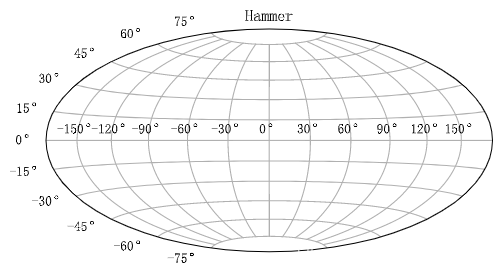
Lambert The mapping procedure is as follows :
plt.figure()
plt.subplot(projection="lambert")
plt.title("Lambert")
plt.grid(True)
Lambert The result is as follows :

Mollweide The mapping procedure is as follows :
plt.figure()
plt.subplot(projection="mollweide")
plt.title("Mollweide")
plt.grid(True)
Mollweide The result is as follows :
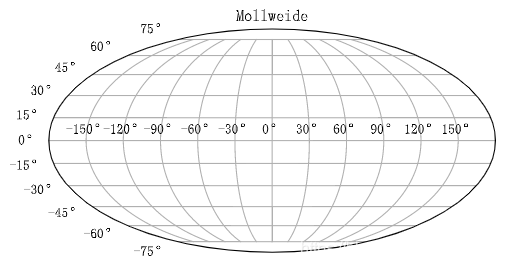
Finally, the most commonly used mapping is introduced polar mapping , That is, the polar coordinate system ,polar The mapping procedure is as follows :
radi = np.linspace(0, 1, 100)
theta = 2*np.pi*radi
ax = plt.subplot(111, polar=True)
ax.plot(theta, radi, color='r', lw=2)
plt.show()
polar The result is as follows :
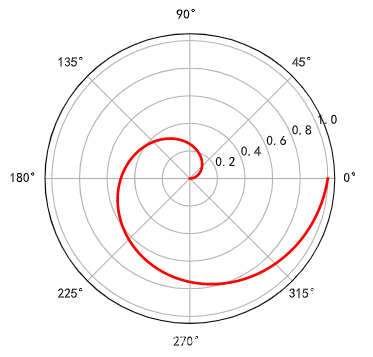
3.3.2 Comprehensive examples
ax = plt.subplot(2, 2, (1, 2))
ax.plot(y+np.random.randn(200), ls='-', lw=2, color='c', label=r'$\sin(x)$')
ax.plot(y1+np.random.randn(200), ls='-', lw=2, color='r', label=r'$\cos(x)$')
ax.legend(title=' Sine and cosine plus noise ', title_fontsize=15, loc='upper right')
ax = plt.subplot(2, 2, 3)
ax.plot(y, ls='-', lw=2, color='c', label=r'$\sin(x)$')
ax.legend(loc='upper right')
ax = plt.subplot(2, 2, 4)
ax.plot(y1, ls='-', lw=2, color='r', label=r'$\cos(x)$')
ax.legend(loc='upper right')
plt.show()
The drawing results are as follows :
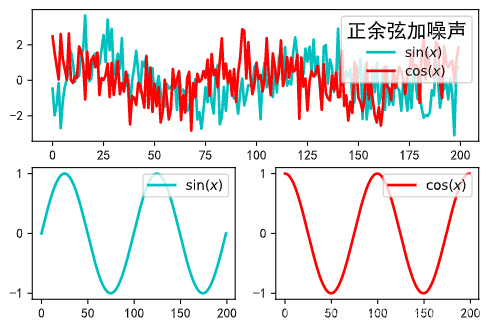
Four .add_subplots function
The method is Figure The class method of class is also the most important internal implementation function of the above two functions .
4.1 Function definition
add_subplot(nrows, ncols, index, **kwargs)
add_subplot(pos, **kwargs)
add_subplot(ax)
add_subplot()
add_subplots The parameters of the function are the same as plt.subplot The parameters of the method are almost the same , I won't repeat it again , You can see the above plt.subplot Function introduction .
4.2 Function explanation
The biggest feature of this method is that it is used as a class method , Its use must have corresponding examples , Instead of using... Like the other two functions gcf() Method calls the current Figure object , That means we can work in multiple Figure Object , Accurately create sub graphs on different objects .
4.3 Example of function
4.3.1 Comprehensive examples
The program shows how to accurately create two Figure Partition on object , The example program is as follows :
import matplotlib.pyplot as plt
import numpy as np
import matplotlib as mpl
mpl.rcParams['font.sans-serif'] = ['SimHei']
mpl.rcParams['axes.unicode_minus'] = False
fig1 = plt.figure(num=1)
fig2 = plt.figure(num=2)
x = np.linspace(-2*np.pi, 2*np.pi, 200)
y = np.sin(x)
y1 = np.cos(x)
ax = fig1.add_subplot(2, 2, (1, 2))
ax.plot(y+np.random.randn(200), ls='-', lw=2, color='c', label=r'$\sin(x)$')
ax.plot(y1+np.random.randn(200), ls='-', lw=2, color='r', label=r'$\cos(x)$')
ax.legend(title=' Sine and cosine plus noise ', title_fontsize=15, loc='upper right')
ax = fig1.add_subplot(2, 2, 3)
ax.plot(y, ls='-', lw=2, color='c', label=r'$\sin(x)$')
ax.legend(loc='upper right')
ax = fig1.add_subplot(2, 2, 4)
ax.plot(y1, ls='-', lw=2, color='r', label=r'$\cos(x)$')
ax.legend(loc='upper right')
x = np.linspace(0, 2 * np.pi, 500)
y = np.sin(x)*np.exp(-x)
ax = fig2.add_subplot(1, 2, 1, title=' Subgraphs 1')
ax.plot(x, y, 'k--', lw=2)
ax.set_title(' Broken line diagram ')
ax = fig2.add_subplot(1, 2, 2, title=' Subgraphs 2')
ax.scatter(x, y, s=10, c='skyblue', marker='o')
ax.set_title(' Scatter plot ')
fig2.subplots_adjust(top=0.8)
plt.show()
The drawing results are as follows :

5、 ... and . summary
Personally, I think the most commonly used must be add_subplot Methods and plt.subplots Method , In general, creating sub areas will not use plt.subplot Method , Its use is to search, not to create . Suppose you need precise control over how to create subareas Figure object , Then use add_subplot Method to create , Usually, if you study or simply draw, you should consider using it directly plt.subplots Method .
6、 ... and . Reference resources
版权声明
本文为[The big pig of the little pig family]所创,转载请带上原文链接,感谢
https://yzsam.com/2022/04/202204230617063777.html
边栏推荐
- Notes on concurrent programming of vegetables (V) thread safety and lock solution
- 【leetcode】102. Sequence traversal of binary tree
- ID number verification system based on visual structure - Raspberry implementation
- Learning note 5 - gradient explosion and gradient disappearance (k-fold cross verification)
- 203、移出链表元素(链表)
- 【leetcode】199.二叉树的右视图
- Jerry sometimes finds that the memory has been tampered with, but there is no exception. How should he find it? [chapter]
- Differences among restful, soap, RPC, SOA and microservices
- What are Jerry's usual program exceptions? [chapter]
- Construction and traversal of binary tree
猜你喜欢

MapReduce compression

解决方案架构师的小锦囊 - 架构图的 5 种类型

SQL Server 游标循环表数据

Solutions to common problems in visualization (VIII) solutions to problems in shared drawing area

【leetcode】199.二叉树的右视图

VIM + ctags + cscope development environment construction guide

【省选联考 2022 D2T1】卡牌(状态压缩 DP,FWT卷积)

Introduction to data analysis 𞓜 kaggle Titanic mission (III) - > explore data analysis

Comparison and practice of prototype design of knowledge service app

Initial exploration of NVIDIA's latest 3D reconstruction technology instant NGP
随机推荐
Introduction to data analysis 𞓜 kaggle Titanic mission (III) - > explore data analysis
[provincial election joint examination 2022 d2t1] card (state compression DP, FWT convolution)
Derivation and regularization
Comparison and practice of prototype design of knowledge service app
Read integrity monitoring techniques for vision navigation systems - 4 multiple faults in vision system
Comparison and practice of prototype design of knowledge service app
Jerry sometimes finds that the memory has been tampered with, but there is no exception. How should he find it? [chapter]
定义链表(链表)
MapReduce compression
24、两两交换链表中的节点(链表)
Windows installs redis and sets the redis service to start automatically
Esp32 learning - use and configuration of GPIO
SQL Server cursor circular table data
203. Remove linked list elements (linked list)
Net start MySQL MySQL service is starting MySQL service failed to start. The service did not report any errors.
图像处理——噪声小记
VScode
1. Sum of two numbers (hash table)
MySql常用语句
206、反转链表(链表)